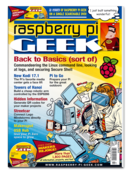Future-proofing the Raspbian SSH Server
Manufacturers of routers and other network devices are notorious both for creating devices with security vulnerabilities and for ignoring new ones discovered during their life cycle. This often includes bugs in key modules such as the Linux kernel, which is embedded into a large number of systems.
One typical security flaw is to use the same login password for all devices. Raspberry Pis running Raspbian fall into this category. On your first install, the default user is always pi and the password is raspberry. You can easily change this using the command passwd, but it's not mandatory, so most Raspberry Pi users don't do this.
As such, if you link a Raspberry Pi to a public network, an attacker can easily locate and connect to it, especially because the Pi promptly responds to ARP scans (Listing 1).
[...]
Buy this article as PDF
Pages: 4
(incl. VAT)







